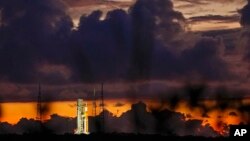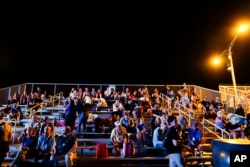The American space agency NASA postponed the launch of its new moon rocket on Monday because of an engine problem.
The launch of NASA’s Space Launch System, or SLS, was called off about 40 minutes before launch time at Kennedy Space Center in Cape Canaveral, Florida.
NASA said on its website that the problem was linked to difficulties cooling the rocket’s main engines to the needed temperature for liftoff. The agency said engineers were continuing to gather data and carry out tests on the engines.
The next launch possibility has been set for Friday, September 2.
NASA has described the 98-meter SLS as the most powerful rocket ever built. It is part of the agency’s Artemis program, which aims to land the first woman and first person of color on the moon.
Artemis seeks to land American astronauts on the moon no earlier than 2025. It would be the first moon landing by astronauts since NASA’s Apollo 17 mission in 1972. Artemis also calls for establishing a long-term base on the moon that could one day launch astronauts to Mars.
NASA is calling the first launch of the SLS rocket Artemis 1. The rocket will carry NASA’s Orion spacecraft, or capsule, on a test mission to fly around the moon.
There will be no astronauts on the spacecraft during the test flight. Instead, three mannequins will be placed inside the crew capsule. They will be connected to a series of sensors designed to measure radiation and movements during the mission.
During the trip, Orion is expected to travel 450,600 kilometers from Earth and thousands of kilometers beyond the moon. NASA said this will be farther than any spacecraft built for humans has ever traveled. The mission is expected to last four to six weeks.
The Associated Press reported NASA officials also discovered communication problems late Sunday involving the Orion spacecraft. The problem was causing a delay in communication lines between launch controllers and Orion. Officials said that problem was solved by Monday morning.
The main purpose of the SLS mission is to test the system for a future flight that will include actual astronauts. NASA has said that if everything goes well with Artemis 1, a trip involving astronauts could be launched as soon as 2024.
SLS has been under development for more than 10 years. It has experienced a series of costly production delays.
Orion will take nearly a week to reach the moon, which is about 386,000 kilometers from Earth. After passing close to the moon, the capsule will enter a distant orbit with a far point of 61,000 kilometers. That will put Orion 450,000 kilometers from Earth.
At the end of the mission, Orion is expected to hit the atmosphere at 40,000 kilometers per hour on its way to a parachute landing in the Pacific Ocean.
I’m Bryan Lynn.
The Associated Press, Reuters and NASA reported on this story. Bryan Lynn adapted the reports for VOA Learning English.
_________________________________________________________________
Words in This Story
mannequin – n. an artificial human form
capsule – n. the part of a spacecraft that carries astronauts
mission – n. a flight by an aircraft or spacecraft to perform a specific task
____________________________________________________________________
What do you think of this story? We want to hear from you. We have a new comment system. Here is how it works:
- 1. Write your comment in the box.
- 2. Under the box, you can see four images for social media accounts. They are for Disqus, Facebook, Twitter and Google.
- 3. Click on one image and a box appears. Enter the login for your social media account. Or you may create one on the Disqus system. It is the blue circle with “D” on it. It is free.
Each time you return to comment on the Learning English site, you can use your account and see your comments and replies to them. Our comment policy is here.











Forum